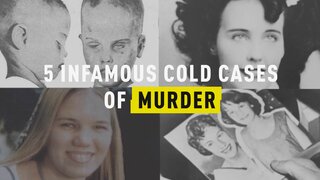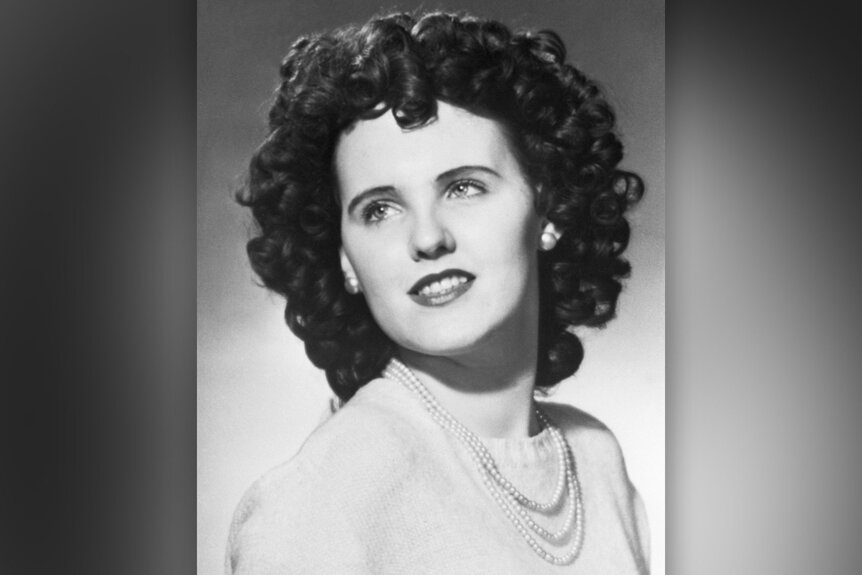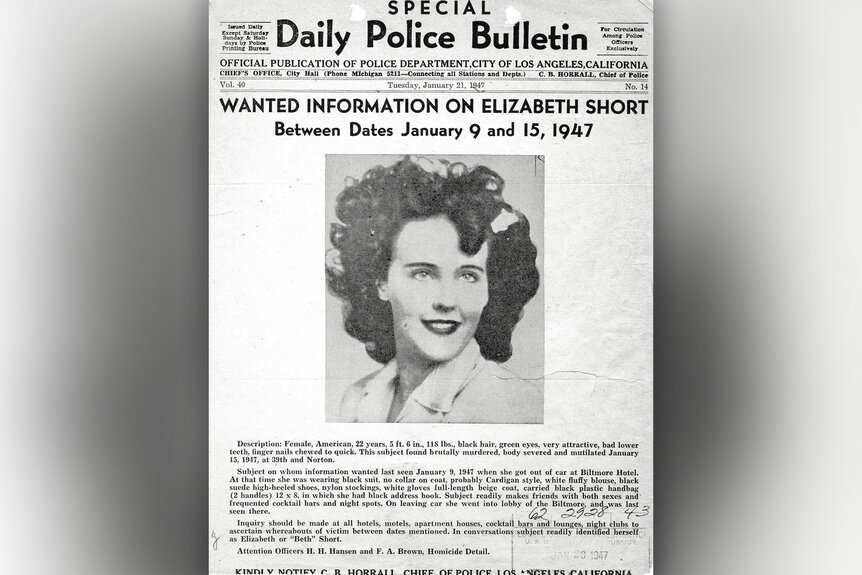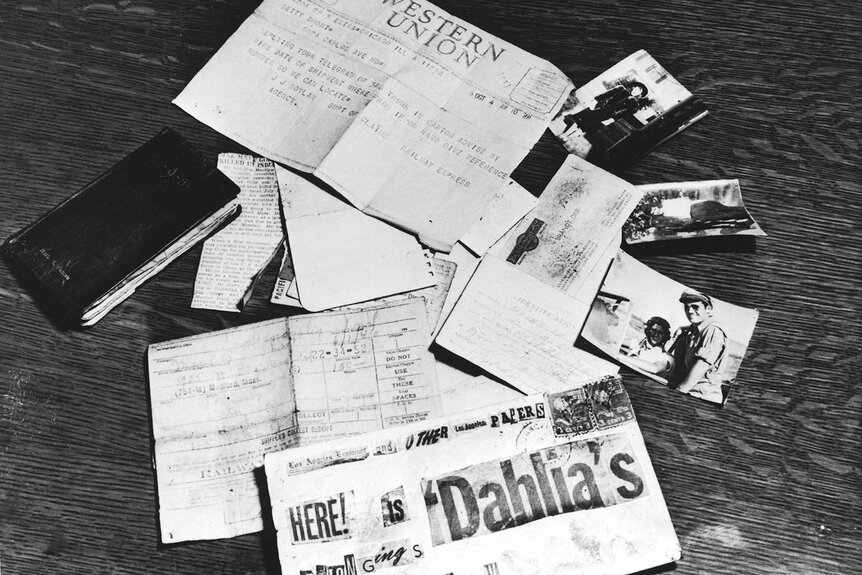Create a free profile to get unlimited access to exclusive videos, breaking news, sweepstakes, and more!
Who Was Black Dahlia Murder Victim Elizabeth Short?
More than 500 people have confessed to the gruesome murder of 22-year-old Elizabeth Short, found nude and bisected in a vacant L.A. lot in 1947, but none of their stories have been deemed credible. LAPD detectives still receive tips in the 76-year-old case that gripped the nation.

Though some accounts of Black Dahlia murder victim Elizabeth Short painted her as an aspiring actress, she had no acting jobs during her short life. But the 1947 discovery of her gruesomely posed corpse in a vacant lot, stripped of clothing and split in two, sparked decades of investigation, speculation and adaptations of her story in film, TV series and literature.
The 22-year-old Boston native had worked as a waitress before the discovery of her body in the Leimert Park neighborhood of South Los Angeles on Jan. 15 of that year — her torso resting a foot away from her lower half. The day after her body was found, the Los Angeles Examiner newspaper sold more copies than it had any other day in its history, save for when it announced the Allied victory in World War II. The Los Angeles Record ran front page stories on her murder investigation for 31 consecutive days, according to The Guardian.
Part of the decades-long intrigue came from the brutality of the killing. Betty Bersinger, who discovered Short's corpse on Norton Ave. while pushing her 2-year-old in a stroller, first thought she was looking at a discarded mannequin. In reality, Short's pallid body had been expertly washed and drained of blood.
The state of the body, its entrails neatly tucked under its buttocks and its uterus expertly removed, led profilers to believe that the perpetrator was a surgeon or physician, according to FBI records. The maiming of Short's face, her mouth cut at the edges into an eerie grin, suggested to investigators that the killer may have known her personally.
Near the scene, investigators with the LAPD found a single heel imprint amidst a tangle of tire tracks and a cement sack containing watery blood.
RELATED: A Mennonite Tragedy: The True Story Behind 'Women Talking'
The Black Dahlia, so named by news outlets after Short's striking black hair and a crime noir film entitled "Blue Dahlia" that was released the previous year, was identified by the LAPD using fingerprints. Due to an earlier arrest in Santa Barbara for underage drinking in 1942, when Short was 18, her prints were on file for investigators to find. The FBI was able to identify her after just 56 minutes using new "Soundphoto" technology to send her fingerprints out to surrounding police departments and news outlets, according to the agency.
An autopsy on Jan. 16 revealed ligature marks, chunks sliced from the victim's breasts and thigh. Her cause of death was a brain hemorrhage, a detail that police and the Bureau kept from news outlets to weed out false confessions.
Although more than 500 men and women have taken credit for the ghastly killing, none of those admissions led to an arrest, according to The Los Angeles Times.
Shortly after the Black Dahlia was identified, The Los Angeles Examiner contacted Short's mother, Phoebe Short, and told her that her daughter had won a beauty contest, according to BBC. Only after prying personal information about the victim did they tell her that her daughter had been murdered.
The Examiner and the Los Angeles Herald-Express sensationalized the case throughout the days following her identification, describing the tailored suit Short had last been seen wearing as a "tight skirt and sheer blouse" and billing her as an "adventuress" who "prowled Hollywood Boulevard."
Not much is definitively known about Short. In childhood, she suffered severe bronchitis and asthma attacks, and underwent lung surgery at 15. She had moved to California from Medford, Massachusetts in 1942 when she was 18 to live with her father.
The following year, she took a job at the Base Exchange at Camp Cooke in Lompoc, then moved to Santa Barbara where she was arrested for underage drinking at a local bar. Juvenile authorities sent her back to Massachusetts, but she quickly relocated to Florida, then back to L.A. in 1946. She was engaged to be married to Air Force Maj. Matthew Michael Gordon Jr. before he died in a plane crash during World War II in 1945. Short spent the subsequent summer doing modeling jobs and building her portfolio. At the time of her death, she was renting a room behind a nightclub on Hollywood Blvd.
In the frenzy following her killing, news outlets went on to make a host of unsubstantiated claims regarding Short's character, according to the Portland Tribune. Outlets speculated she was a sex worker, a lesbian or pregnant. After Short's stripper acquaintance told police she "liked to get guys worked up over her, but she'd leave them hanging dry," reporters scoured L.A. gay bars for any clues surrounding her killing.
On Jan. 24, more than a week after Short's body was found, a postal worker found a suspicious package addressed to "the Los Angeles Examiner and other Los Angeles papers" with words that had been cut from newspaper clippings. The packaged contained Short's birth certificate, business cards, photographs, names written on pieces of paper, and an address book with the name Mark Hansen on the cover. Like Short's body, the package was cleaned with gasoline.
Hansen was a wealthy night club and theater owner, according to reporting by Rolling Stone, and police quickly deemed him a suspect. An acquaintance of Short, he had reportedly allowed her and her friends to stay over at his apartment, and according to Short's friend Ann Toth, had recently been rejected by the victim. But he was ultimately cleared of suspicion in the case.
In addition to Hansen, the LAPD interviewed more than 150 male suspects in the killing. Robert "Red" Manley, a 25-year-old married salesman whom Short had allegedly been dating and last saw on Jan. 9 of that year, was among them, according to Cathy Scott's "The Crime Book." He was cleared of suspicion by several polygraph tests.
That afternoon, Manley told police, he dropped Short off at the Biltmore Hotel, where employees said they saw her using a payphone. Manley also said she had planned to see her sister, who was visiting from Boston, but it's unclear whether the two ever met.
Another letter allegedly sent from the purported killer, this one handwritten, was received by the Examiner on Jan. 26. It read: "here it is. Turning in Wed., Jan 29 10 am. Had my fun at police. Black Dahlia Avenger." The letter named a location where the supposed suspect would turn himself in, but he did not appear. Instead, the news outlet's offices received another letter on 1 p.m. that day, this time cut and pasted from news print, reading: "Have changed my mind. You would not give me a square deal. Dahlia killing was justified."
From there, the Los Angeles Daily News wrote on Feb. 1, the investigation hit a "stone wall." In a desperate bid for further leads, according to FBI records, the LAPD issued a warrant to the University of Souther California Medical School, requesting a complete list of the program's students for a background check, to no avail.
On March 14, what appeared to be a suicide note written by the supposed killer was found tucked into a shoe amid a pile of men's clothing by the ocean on Breeze Ave. in Venice. The note read: "To whom it may concern: I have waited for the police to capture me for the Black Dahlia killing, but have not. I am too much of a coward to turn myself in, so this is the best way out for me. I couldn't help myself for that, or this. Sorry, Mary."
But the clothes gave no clue as to the identity of their owner, and investigators were inundated with false confessions. City Councilman Lloyd G. Davis posted a $10,000 reward for information leading police to Short's killer. This led to several false confessors, including housewives, soldiers, farmers and even clergymen, some of whom were charged with obstruction of justice.
A former member of the Women's Army Corps told detectives that "Elizabeth Short stole my man so I killed her and cut her up," according to the Los Angeles Times. Another man reportedly confessed to the crime on four separate occasions at L.A. police headquarters, earning himself the nickname "Confessin' Tom."
Skeptical detectives reportedly asked one confessor to pick out Short from a series of photographs. He could not, and tried to stagger away. Police, realizing he was inebriated, threw him in the drunk tank.
>By Spring of that year, despite the 750 LAPD investigators, 400 sheriff's deputies and 250 California State Patrol Officers assigned to the case, the trail had gone cold.
But even when the LAPD and FBI's files had begun accumulating dust, the literary and film worlds gave the Black Dahlia case new life. John Gregory Dunne published "True Confessions," a book loosely based on the murder, in 1977. In 1987, James Ellroy published "The Black Dahlia," another fictional account. That novel was developed into a film in 2006, starring Mia Kirschner as Short and also featuring Scarlett Johansson.
The TV movie "Who is the Black Dahlia" first aired in 1975, and reportedly still lands detectives a spate of calls each time it's shown.
Former LAPD officer Steve Hodel has spent the last 15 years cataloguing evidence he believes implicates his own father, physician George Hodel, as the killer, according to The Guardian. He has served with the LAPD for 23 years, establishing himself as an unfaltering homicide detective. But his theory regarding the Black Dahlia case has not been confirmed by investigators.
Hodel's investigation reportedly began after he found a photograph resembling Elizabeth Short among his father's things. Hodel published that catalogue of evidence, entitled "The Black Dahlia Avenger," after the anonymous writer of letters to the Examiner in 2003. The book quickly topped the New York Times best seller list.
Numerous others have written books about the case claiming to know Short's killer. A woman named Janice Knowlton believed, too, that her father had killed the woman in 1947, according to the Los Angeles Times.
After more than 70 years, the Black Dahlia murder case remains open, and has maintained its place as one of the most gruesome, captivating murders in California history.





























